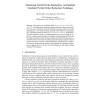Free Online Productivity Tools
i2Speak
i2Symbol
i2OCR
iTex2Img
iWeb2Print
iWeb2Shot
i2Type
iPdf2Split
iPdf2Merge
i2Bopomofo
i2Arabic
i2Style
i2Image
i2PDF
iLatex2Rtf
Sci2ools
CAV
2009
Springer
2009
Springer
Monotonic Partial Order Reduction: An Optimal Symbolic Partial Order Reduction Technique
Abstract. We present a new technique called Monotonic Partial Order Reduction (MPOR) that effectively combines dynamic partial order reduction with symbolic state space exploration for model checking concurrent software. Our technique hinges on a new characterization of partial orders defined by computations of a concurrent program in terms of quasi-monotonic sequences of thread-ids. This characterization, which is of independent interest, can be used both for explicit or symbolic model checking. For symbolic model checking, MPOR works by adding constraints to allow automatic pruning of redundant interleavings in a SAT/SMT solver based search by restricting the interleavings explored to the set of quasi-monotonic sequences. Quasi-monotonicity guarantees both soundness (all necessary interleavings are explored) and optimality (no redundant interleaving is explored) and is, to the best of our knowledge, the only known optimal symbolic POR technique.
CAV 2009 | Formal Methods | Partial Order Reduction | Symbolic Model Checking | Symbolic Por Technique |
| Added | 25 Nov 2009 |
| Updated | 25 Nov 2009 |
| Type | Conference |
| Year | 2009 |
| Where | CAV |
| Authors | Vineet Kahlon, Chao Wang, Aarti Gupta |
Comments (0)

